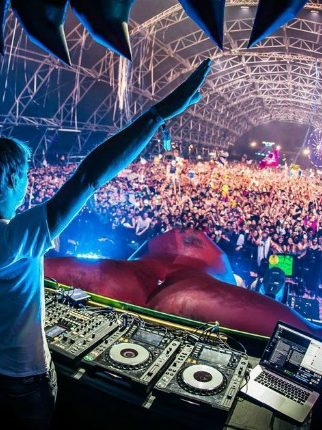Roger Sanchez: A Straight-Up New York Vibe

“I put my mind in a state of hunger, and that’s what an artist should always be—hungry, as far away from complacency as possible. A life in music is like a fire, and fire will consume. If you don’t refuel it consistently, eventually that combustible will burn out.”
I am chilling in a Hell’s Kitchen coffee shop on an early summer afternoon with NYC legend Roger Sanchez. For those that don’t know, Roger has been on his hustle since his teenage years. The Corona native with Dominican roots was drawn to art early and attended the prestigious High School of Art and Design, then matriculated at Pratt Institute’s School of Architecture. Growing up in a musically rich environment—salsa, merengue, early hip-hop—Roger became interested in graffiti and the b-boy life.
I started as a breakdancer and graf writer, and that’s how I got my introduction into DJing. I had friends who were DJing, and I would watch them. We would go to Bronx River parties, Zulu Nation jams; there was music, dancing and graffiti. It was a very powerful combination, and there was no social media or advertising—this was a localized but growing culture, a straight-up New York vibe.

Roger began DJing, learning how to cut and mix breaks in songs, looping the fat parts between two 12-inches, beat matching, etc. He also became active in the whole digging subculture, looking for breaks, hitting various shops (Rock-n-Soul, Vinylmania) posting up to get the new jams as they dropped.
“I had one of those Gemini mixers with the little mini sampler, and at first some belt drive Technics with the dial-in pitch control,” he laughs. “Sampling, finding these great parts in these disparate musical forms opened up a huge door. Sound became a tool—the idea of not just playing, but using these parts, became very appealing.”
Roger’s immersion in the culture got deeper when he started attending seminal parties like The Loft and The Paradise Garage, as well as spots like 1018, The Roxy and The World. Around this time, Roger began selling mixtapes down on Broadway out of his car, and it was becoming clear that this wasn’t just a hobby.
“Selling the mixtapes, I would use that money to help cover any bar guarantees that some of those smaller places had for my gigs,” he remembers. “It also was a motivational thing, to go downtown and sell my mixes out of the trunk of my car. I had to hustle and believe in what I was doing. I had a talk with my Dad, who was an engineer, and he encouraged me to put the architecture on the back burner and follow this full time. His support at that key moment was huge for me.”
Roger soon was full-on, playing at places like The Tunnel and Mars and getting seriously into production. Under the name Ego Trip, he got picked up by Quark’s Curtis Urbina, who put out his first 12-inch, “Dreamworld,” on the Outer Limits imprint.
“Curtis heard some of my demos, gave some valuable feedback, and helped me get that first jam out,” says Sanchez. “Then that became a huge techno record in the North of England.”
Armed with an SP-1200, a LinnDrum, a KY 30, a TR-909 and ¼-inch tape machine for multitracking, he started releasing stuff for Gladys Pizarro at Strictly Rhythm records. “Luv Dancin,” his first production for them (as Underground Solution), featured a characteristic mix of sampling, electronic sounds, and a live vocal by Jasmine.
“This track started to get play by Tony Humphries at Zanzibar, and that really launched me,” he says. “I started touring with Todd Terry for Strictly Rhythm, and it was on.”
It is advisable, young reader, to spend a YouTube night with the Strictly Rhythm catalogue. Roger’s various productions and the work of his contemporaries, some guys name Kenny and Louie, Kyle Smith, Eric Morello, DJ Pierre, and Wayne Gardener, among others, created a blueprint for hard-edged club music with a grimy street vibe. Roger’s work for them included such influential burners like “Old School House,” “Get Hi,” “Strictly 4 the Underground” and “C’mon.”
I think the integrity and vibrancy of dance music’s underground legacy, both sonically and lyrically, are essential to keep moving to that new thing.
Firmly established with his Strictly Rhythm catalogue, Roger pushed hard and achieved the global fame and success he now maintains. He’s also done remixes for artists as diverse as The Police, Jamiroqui, No Doubt (for which he won a Grammy), Michael Jackson, Incognito, Luther Vandross, and countless others. Go look at his Discogs page, then consider your “I’ll finish that mix tomorrow” mindset. He has some great classic edits and numerous DJ mixes and compilations, and he has run four different labels (check out Narcotic and Stealth Recordings). He was also an early advocate of podcasting, and he still hosts a weekly terrestrial and online show, Release Yourself. Simply put, he goes to work.
Roger has held down influential residencies in Ibiza for over a decade (Pacha, Space) and can be seen worldwide on some of the best sound systems, like Cielo in NYC, Stereo in Montreal, and London’s Ministry of Sound. With all this success, though, he has maintained an edge to keep pushing forward and reinventing himself.
“I’ve built about five separate studios, constructed them from the ground up. I work with several different engineers, but I do all the work myself. I used a pianist for a while, then I taught myself how to play well enough to get what I need. It is a good metaphor for how I feel the artistic process should happen: You make a context, saturate it, and then start again from scratch.
On his new imprint, Undr the Radr, Roger has released “Dangerous Thoughts,” a dirty, stripped-down, bass-heavy jam with a lyric that goes right for it: “I’ve been thinking ‘bout, how you all sound the same, your style is mad fake, like that rep that you claim.” It is a New York neighborhood head check, and you can hear Miami bass, Detroit, Chicago and Bambaataa, as well as his own history in the track’s engine. It sounds unmediated and driven, and it could be played in a big room or small basement. It also, despite its inherent challenge to the status quo, is devoid of nostalgia.
“I wanted to bring a sense of rawness that was informed by my history and experience, but I wanted it for right now,” he says. “There has been so much crossover in the explosion of electronic dance music, and with mass appeal, things often get diluted. I think the integrity and vibrancy of dance music’s underground legacy, both sonically and lyrically, are essential to keep moving to that new thing.”
Follow Roger Sanchez on Facebook | Twitter


